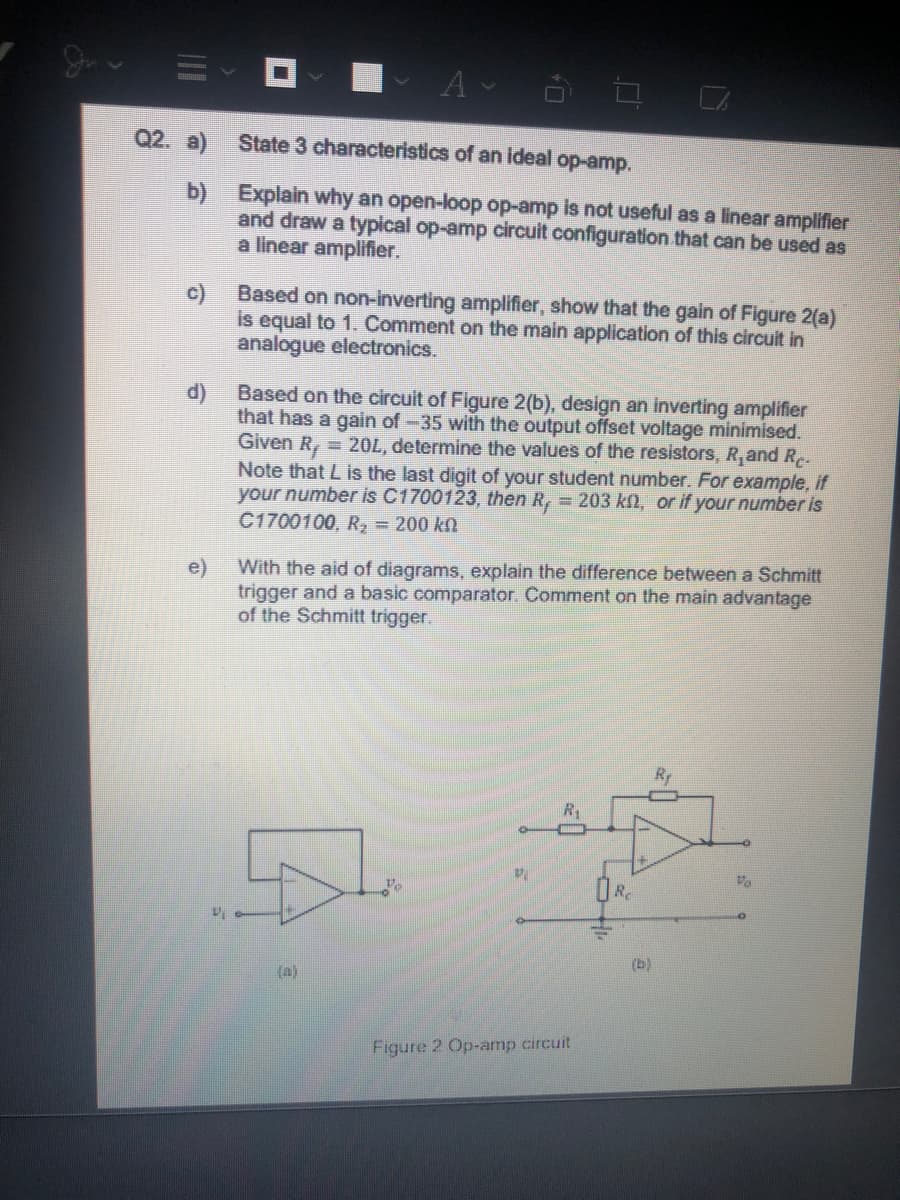Q2. a) State 3 characteristics of an ideal op-amp. b) Explain why an open-loop op-amp is not useful as a linear amplifier and draw a typical op-amp circuit configuration that can be used as a linear amplifier.
Q2. a) State 3 characteristics of an ideal op-amp. b) Explain why an open-loop op-amp is not useful as a linear amplifier and draw a typical op-amp circuit configuration that can be used as a linear amplifier.
Introductory Circuit Analysis (13th Edition)
13th Edition
ISBN:9780133923605
Author:Robert L. Boylestad
Publisher:Robert L. Boylestad
Chapter1: Introduction
Section: Chapter Questions
Problem 1P: Visit your local library (at school or home) and describe the extent to which it provides literature...
Related questions
Question
A) and B)

Transcribed Image Text:A -
Q2. a)
State 3 characteristics of an ideal op-amp.
b) Explain why an open-loop op-amp is not useful as a linear amplifier
and draw a typical op-amp circuit configuration that can be used as
a linear amplifier.
c)
Based on non-inverting amplifier, show that the gain of Figure 2(a)
is equal to 1. Comment on the main application of this circuit in
analogue electronics.
Based on the circuit of Figure 2(b), design an inverting amplifier
that has a gain of-35 with the output offset voltage minimised.
Given R, = 20L, determine the values of the resistors, R, and Re.
Note that L is the last digit of your student number. For example, if
your number is C1700123, then R, = 203 kn, or if your number is
C1700100, R2 = 200 kn
d)
With the aid of diagrams, explain the difference between a Schmitt
e)
trigger and a basic comparator. Comment on the main advantage
of the Schmitt trigger.
Ry
R.
(b)
(a)
Figure 2 Op-amp circuit
Expert Solution
This question has been solved!
Explore an expertly crafted, step-by-step solution for a thorough understanding of key concepts.
Step by step
Solved in 2 steps with 2 images

Knowledge Booster
Learn more about
Need a deep-dive on the concept behind this application? Look no further. Learn more about this topic, electrical-engineering and related others by exploring similar questions and additional content below.Recommended textbooks for you

Introductory Circuit Analysis (13th Edition)
Electrical Engineering
ISBN:
9780133923605
Author:
Robert L. Boylestad
Publisher:
PEARSON

Delmar's Standard Textbook Of Electricity
Electrical Engineering
ISBN:
9781337900348
Author:
Stephen L. Herman
Publisher:
Cengage Learning

Programmable Logic Controllers
Electrical Engineering
ISBN:
9780073373843
Author:
Frank D. Petruzella
Publisher:
McGraw-Hill Education

Introductory Circuit Analysis (13th Edition)
Electrical Engineering
ISBN:
9780133923605
Author:
Robert L. Boylestad
Publisher:
PEARSON

Delmar's Standard Textbook Of Electricity
Electrical Engineering
ISBN:
9781337900348
Author:
Stephen L. Herman
Publisher:
Cengage Learning

Programmable Logic Controllers
Electrical Engineering
ISBN:
9780073373843
Author:
Frank D. Petruzella
Publisher:
McGraw-Hill Education

Fundamentals of Electric Circuits
Electrical Engineering
ISBN:
9780078028229
Author:
Charles K Alexander, Matthew Sadiku
Publisher:
McGraw-Hill Education

Electric Circuits. (11th Edition)
Electrical Engineering
ISBN:
9780134746968
Author:
James W. Nilsson, Susan Riedel
Publisher:
PEARSON

Engineering Electromagnetics
Electrical Engineering
ISBN:
9780078028151
Author:
Hayt, William H. (william Hart), Jr, BUCK, John A.
Publisher:
Mcgraw-hill Education,